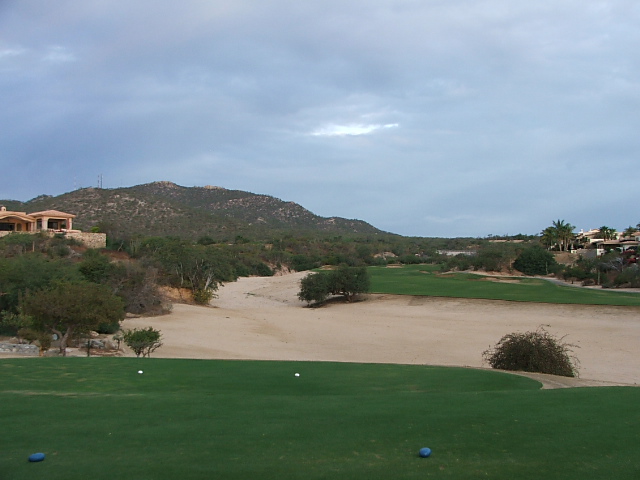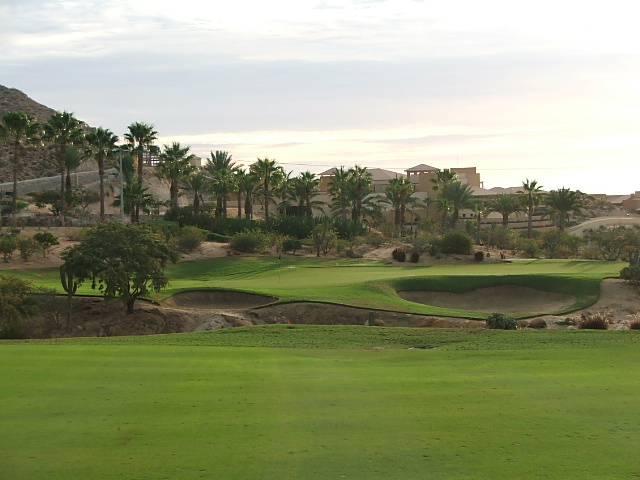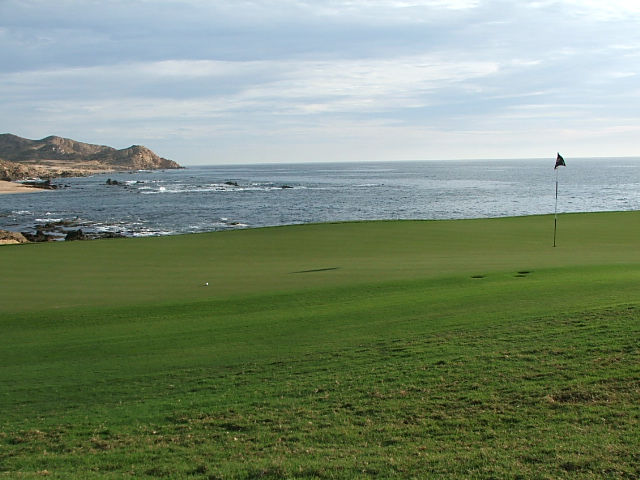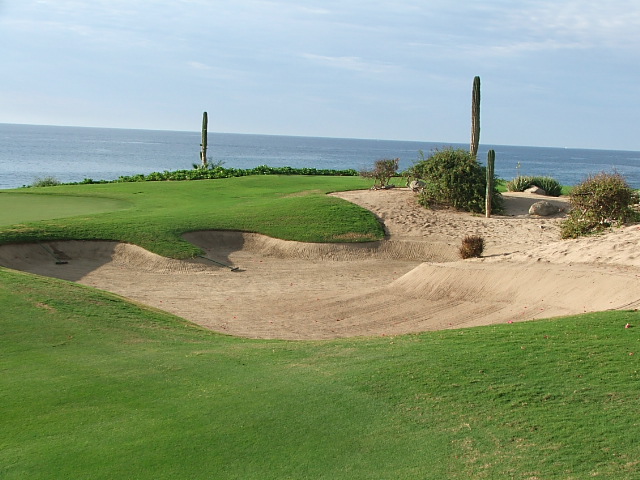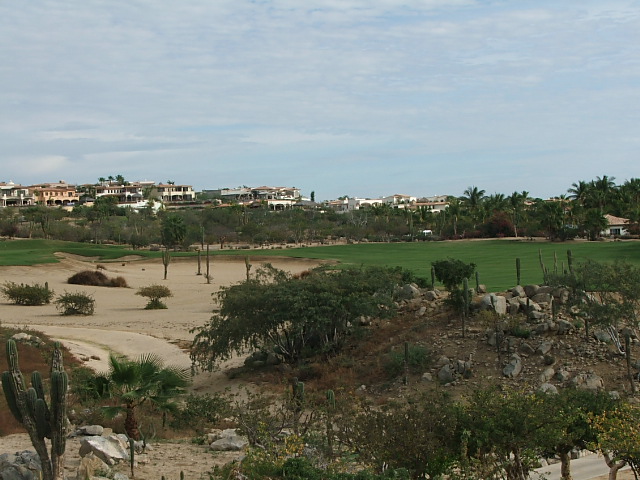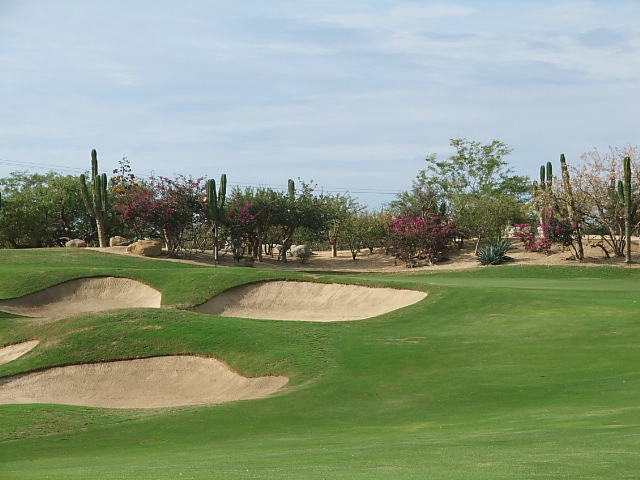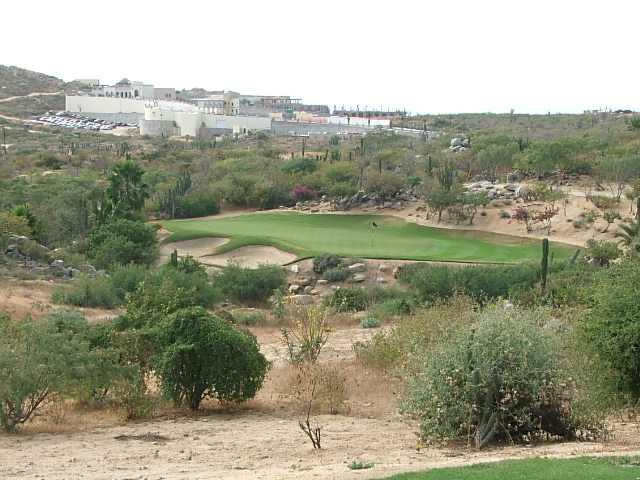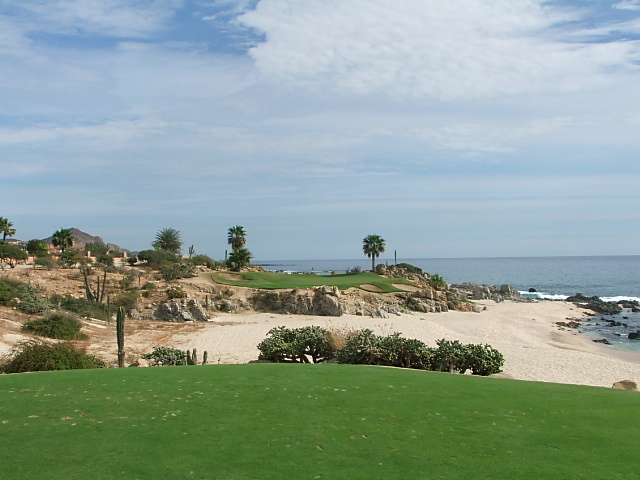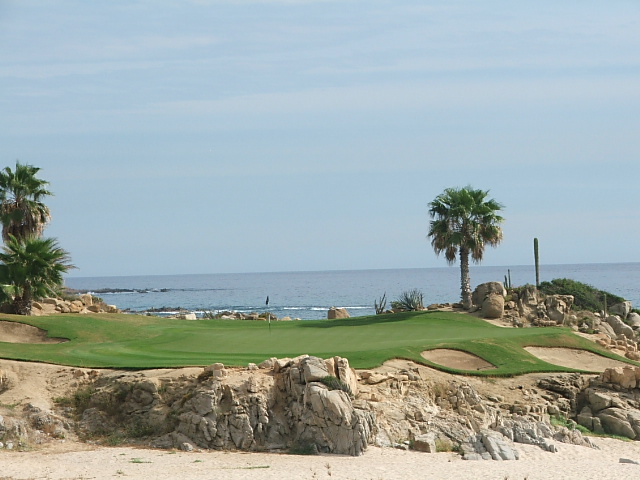
The flight was uneventful and we arrived in Mexico to experience one of life's simple pleasures. That is, flying from a cold climate in the winter, arriving in the tropics and walking out of the plane directly onto an open stairway, with the warm sun beating down on you. It is a redeeming experience and is a much better way to arrive than walking through a jetway, through an air-conditioned terminal that is hermetically sealed.
It has always been a curiosity to me why no desert golf courses are ranked in the world's top 100 golf courses. There are many fine courses in Arizona, Nevada and Palm Springs that provide an enjoyable, different type of golfing experience -- that of target golf. The name of the golf course ranked #68 in the world threw me off -- Cabo Del Sol (Ocean). In reality it is a desert golf course laid out with islands of both green and fairway set among the desert.
I played the Jack Nicklaus-designed Cabo Del Sol (Ocean) under fine conditions this past February: seventy degree weather, a mild breeze, in the first group off the tee, with the sun rising over the water. It was my first round wearing shorts in six months and it felt great to play in such a nice location. You can see the brilliant day unfolding at Cabo del Sol below, with the cacti providing a nice frame to the sunrise.
The summary of the landscape at Cabo del Sol is: The desert meets the ocean. The summary of the golf course is: Jack Nicklaus-style forced carry shots and fast greens.
The first tee shot of the day, seen above, is typical of what you face all day at Cabo Del Sol: a forced carry over the desert.
4th approach to green
Often times, shots to the green at Cabo del Sol also require a forced carry over desert as well. The approach to the par five fourth hole, above, requires you to hit a shot over about 60 yards of desert and over a ravine, to an elevated green.
Cabo del Sol is located in the Mexican state of Baja California in Cabo San Lucas. Baja California is a peninsula of land between the Pacific Ocean and the Gulf of California. The course overlooks the Sea of Cortés and was opened in 1994. The course starts away from the water on a desert plateau and then gradually plays downhill until it reaches the water at the par three sixth hole.
The par three 6th hole
This 165 yard par three is situated in a dramatic setting among the craggy rocks right on the sea. The setting is made even more spectacular by the whales that fill the expanse behind this hole. Grey whales migrate the 12,400 miles to Cabo in the winter from Alaska to mate here. Whales are clearly an intelligent species spending their winters in Mexico! The water immediately offshore is extremely deep, which is what attracts the whales here. As you play the holes along the water, and this one in particular, you can see them continually jumping up in the water and also shooting plumes of water into the sky. I suggest playing Cabo del Sol between December and April so you experience the whales while you play.
Par three 6th hole
The par three sixth is one of the prettiest of its kind anywhere in the world and for my money rivals Pebble Beach's seventh for scenic beauty.
Behind the 7th green
The dramatic par three sixth is followed by another par three, the seventh, which is a 137 yard hole that plays at a ninety degree angle to the sixth and is parallel to the water. You can see the curious juxtapositions at Cabo del Sol, above, where Cactus plants in the desert meet the ocean. The sixth and seventh are the only holes along the water on the front nine. You don't return to the water until holes sixteen through eighteen, which finish along the sea. At this point, the course is routed back inland and plays up the plateau and then back down it again for the closing stretch of holes.
The view from the 11th tee
The 11th hole is a classic risk-reward hole. A very short par four at 328 yards, the hole offers a generous lay-up area down the entire right side. What is tantalizing, however, is that you can hit your drive just short of the green by hitting over the vast desert area on the left. Take the risk and you will have a very short shot to the green and a very good angle of approach. Miss it and you'll be down in the sand for a bit. Jack Nicklaus's courses can sometimes be overbearing and too difficult to play. I didn't find that to be the case at Cabo del Sol. As with this hole, the overall course is a nice bit of Nicklaus design.
12th hole, approach to green
The twelfth hole is a 473 yard par five and the picture above is the approach to the elevated and well bunkered green.
Downhill par three 13th
The 171 yard downhill par three 13th hole, seen above, again demonstrates the forced carry present on every hole. The greens at Cabo del Sol are among the best I have played in all my travels. They were in ideal condition when I played and were very fast.
A desert hazard at Cabo del Sol
The signature 16th hole
The sixteenth hole is the signature hole at Cabo del Sol and is featured on its scorecard. It is a 342 yard par four that plays downhill. The approach shot to the green should obviously not be long.
The par three 17th
The seventeenth hole, pictured above, is another forced carry to a beautiful, small green perched between the ocean and the desert. It is somewhat reminiscent of Pete Dye's Casa de Campo where he built several holes into the water. Golf Magazine has also compared this hole to the sixteenth at Cypress Point.
The 17th green
The eighteenth is a disappointing hole that plays along the water but doesn't really take advantage of the great terrain and beautiful setting. According to its website, Jack Nicklaus calls Cabo del Sol "the best three finishing holes in all of golf." I don't agree. Carnoustie is the clear winner here, followed by Merion and the National Golf Links of America.
You must take a cart at Cabo del Sol because the walk between green and tee is often quite long. The greens fee is steep at $325, but then again, you are playing one of the world's best golf courses in a dramatic location. Cabo del Sol was the first time I had tacos for breakfast, at the half-way house between the nines. It know it sounds unusual, but they are included in the cost of your round, and they are delicious.
Cabo del Sol is a worthy desert course among the world's top 100. Similar to Pebble Beach and Turnberry, Cabo del Sol also has a hotel on the property and I suggest staying there to soak up the experience and enjoy the great views.
The Cabo Del Sol web-site

